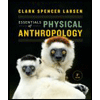Lizard Lab Module 1 + 3
pdf
keyboard_arrow_up
School
University of New Hampshire *
*We aren’t endorsed by this school
Course
412
Subject
Anthropology
Date
Apr 3, 2024
Type
Pages
3
Uploaded by BrigadierKomodoDragonMaster894
Module 1 Questions: 1. At the beginning of the virtual lab, you were asked to sort eight lizards into categories. What criteria did you initially use to make your groups? Did you revise your criteria later? Why? I first sorted them into two categories by location of where they are located: Hispaniola and Puerto Rico. I then revised my criteria sorting them into groups based on their color as I could create more categories that way that are more related to the lizards themselves. Once measuring the lizards, I changed the groupings from their colors to their tail lengths and toe pad sizes as that gave an even larger number of groupings. 2. An adaptation is a structure or function that is common in a population because it enhances the ability to survive and reproduce in a particular environment. Provide one example and an explanation of one adaptation in the Anolis lizards. An example of an adaptation in the Anolis lizards is the Trunk-crown anoles developing larger toe pads that allow them to grip onto the slippery leaves higher up in the tree where they are typically located so they can survive better in this habitat. 3. Provide one evolutionary explanation for why lizards living in the same part of the habitat (i.e., grass) would have similar characteristics. Lizards living in the same habitat/environment would have similar characteristics because, over time, the population evolves to ensure survival within this population. Those more fit to survive will outlive those who are not fit and then pass their genes onto the next generation. This will cause the lizards in close proximity to have similar traits. 4. What is an ecomorph? Provide one example from the virtual lab. Ecomorphs are species that have similar morphologies occupying similar areas or niches. These organisms are also referred to as habitat specialists. An example from the virtual lab is the Twig-anoles live higher in the trees and their morphology is diRerent than the Trunk-anoles that stay closer to the ground. 5. How is an ecomorph diRerent from a species? An ecomorph is a group of individuals that live in similar conditions and have similar characteristics. This does not necessarily mean they are the same species. Ecomorphs can contain multiple species. Individuals of the same species can reproduce with each other, but not all individuals in an ecomorph are of the same species so they cannot reproduce with every other individual within the ecomorph.
6. Explain how a particular body feature of one of the lizard ecomorphs from the virtual lab is an adaptation to their particular niche. Another body feature of a lizard from this lab that is an example of an adaptation for their specific niche is the Twig anoles. They have short legs allowing as they mostly reside on small branches of trees. This is an adaptation as the short legs allow them to be closer to the branches so they can balance better on the thin twigs. Module 3 Questions: 1.In Dr. Losos’s experiment, why was it important that the experimental islands lacked lizards? It is important that the experimental islands with the small bushes lacked lizards originally because then the scientists could study how the new population forms and evolves to the new habitat after introducing the lizards from the other island that had tall trees. 2. Dr. Losos’s data suggest that after only a few generations, the lizards on the experimental islands have shorter legs on average than the lizards on the larger island. Explain how the data you collected either supports or does not support this claim. The data I collected does support this claim as the mean relative hindlimb lengths for the lizards on the larger island was higher than the mean relative hindlimb length for the lizards on the experimental island. 3. Based on what you know about the experimental islands and the lizards that were placed on these islands, explain how and why the average leg length of the population might change over time. Include the concept of natural selection in your discussion. The average long length may change over time as Individuals with the ideal leg length outlive those with less ideal leg lengths and reproduce more, passing their ideal leg length genes on to the next generation. This is natural selection, the fittest survive and pass on their genes so the population is better fit to survive in the future. 4. If the population from one of the experimental islands were reintroduced on the original island, do you predict that lizards from the two populations would still mate and reproduce? Justify your answer with scientific arguments. If there is enough time in between where the new population was able to evolve so much to where it became a new species, then they would not be able to reproduce. However if there has not been a significant change or chance of fully evolving, then the lizards would be able to reproduce.
Your preview ends here
Eager to read complete document? Join bartleby learn and gain access to the full version
- Access to all documents
- Unlimited textbook solutions
- 24/7 expert homework help
Related Documents
Recommended textbooks for you

Essentials of Physical Anthropology (Third Editio...
Anthropology
ISBN:9780393938661
Author:Clark Spencer Larsen
Publisher:W. W. Norton & Company
Recommended textbooks for you
 Essentials of Physical Anthropology (Third Editio...AnthropologyISBN:9780393938661Author:Clark Spencer LarsenPublisher:W. W. Norton & Company
Essentials of Physical Anthropology (Third Editio...AnthropologyISBN:9780393938661Author:Clark Spencer LarsenPublisher:W. W. Norton & Company

Essentials of Physical Anthropology (Third Editio...
Anthropology
ISBN:9780393938661
Author:Clark Spencer Larsen
Publisher:W. W. Norton & Company